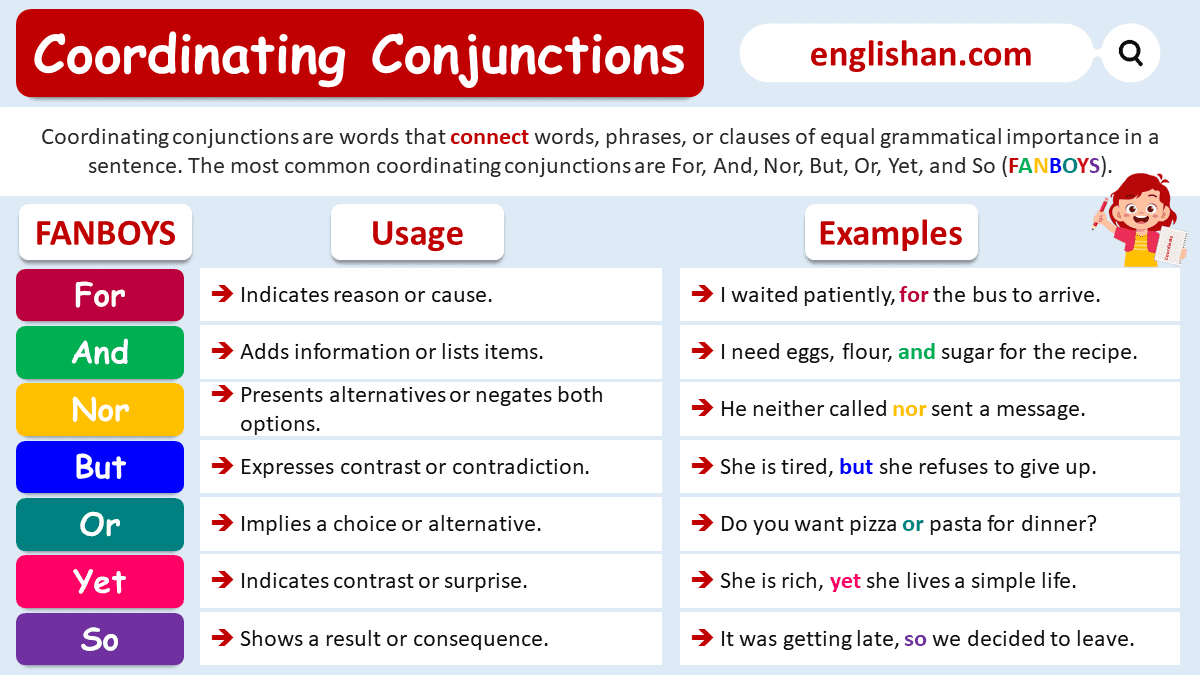Contents
Coordinating conjunctions are used to join words, phrases, or clauses of equal importance. Common ones include and, but, or, and so. These words appear in many English sentences and help form correct sentence structure. In this post, you’ll learn their types, functions, and sentence-level usage through definitions and examples. The focus is to explain how coordinating conjunctions work in grammar and how to apply them accurately.
What Are Coordinating Conjunctions
Coordinating conjunctions are used to connect two equal parts of a sentence, like two subjects or two verbs. They help join similar ideas, contrast different points, or show results. These conjunctions do not make one part dependent on the other.
List of Coordinating Conjunctions with FANBOYS
Below is a list of all coordinating conjunctions in English. The word FANBOYS is a helpful trick to remember them. Each letter stands for one conjunction. These are the only seven coordinating conjunctions used in English grammar.
- For: Explains reason or purpose
She stayed inside for it was raining. - And: Adds one idea to another
He plays guitar and sings too. - Nor: Connects two negative ideas
She didn’t call nor did she write. - But: Shows contrast
He is fast but not careful. - Or: Offers choices
Would you like tea or coffee? - Yet: Expresses contrast, like “but”
It was late, yet they kept working. - So: Shows result or effect
He missed the bus, so he walked home.
Types of Coordinating Conjunctions
Each coordinating conjunction serves a different purpose. Below is a list that shows how each one works in a sentence and what it expresses.
- Addition: And – Joins similar ideas or actions
They danced and laughed all night. - Contrast: But, Yet – Shows difference or unexpected result
He was tired, yet he kept reading. - Choice: Or, Nor – Presents options or alternatives
You can call me or text me. - Cause/Reason: For – Explains why something happens
He wore a jacket for it was cold. - Effect/Result: So – Shows the result of an action
She studied hard, so she passed.
Coordinating Conjunction Example Sentences
Here are example sentences that use coordinating conjunctions. The words in bold are the conjunctions being used.
- I wanted to sleep but I had homework.
- He speaks French and Spanish fluently.
- You can take the bus or walk.
- It started raining, so we stayed home.
- She didn’t like coffee nor tea.
- They tried hard, yet they failed.
- I brought my coat for the weather looked bad.
Coordinating vs Subordinating Conjunctions
Coordinating and subordinating conjunctions both join parts of a sentence, but they work differently. Below is a list of their key differences.
- Coordinating Conjunctions: Connect equal parts (like two full sentences)
She sang and he danced. - Subordinating Conjunctions: Connect unequal parts (a main clause and a dependent clause)
She stayed home because it was snowing. - Punctuation Rule: Coordinating conjunctions use a comma before them when joining two full sentences
He was late, but he finished the work. - Number of Words: There are only 7 coordinating conjunctions. Subordinating ones include because, although, if, when, and more.
- Meaning Control: Coordinating doesn’t change sentence emphasis. Subordinating often makes one part less important.
Practice Exercises
Try the exercises below to check your understanding of coordinating conjunctions.
- Fill in the blank with the correct coordinating conjunction:
- I was tired, ___ I went to bed early.
- Do you want pizza ___ pasta for dinner?
- She doesn’t like sweets, ___ does she enjoy soda.
- He ran fast, ___ he won the race.
- Combine the sentences using the correct conjunction:
- She likes drawing. She hates coloring.
- He reads books. He watches documentaries.
- It is raining. We are going out.
- I was hungry. I didn’t eat.
Coordinating Conjunction FAQs
A coordinating conjunction connects words, phrases, or clauses that are of equal importance.
The most common coordinating conjunctions are and, but, or, so, yet, for, nor.
Examples:
1. I like apples and bananas.
2. She was tired, but she kept working.
These words help join ideas in a sentence.
There are 7 main coordinating conjunctions, remembered using the acronym FANBOYS:
1. for
2. and
3. nor
4. but
5. or
6. yet
7. so
These are the primary coordinating conjunctions. Sometimes, people include additional words like then, still, only, else, and nevertheless in certain contexts, but FANBOYS are the standard 7 used in grammar.
Examples:
I was hungry, so I ate dinner.
She likes tea, but he prefers coffee.
Yes. And is a coordinating conjunction. It joins equal parts in a sentence.
Example: She likes apples and oranges.
No. As is a subordinating conjunction, not coordinating. It introduces reasons or comparisons.
Example: She left early as she wasn’t feeling well.
No. Because is a subordinating conjunction used to show reason.
You May Also Like
